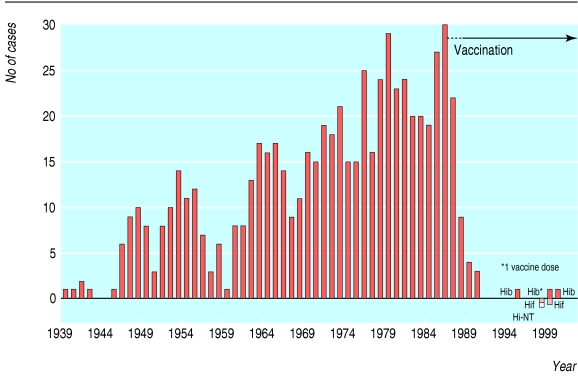Despite the spectacular success of Haemophilus influenzae type b (Hib) conjugate vaccines in the developed world,1 failures have become more common in the Netherlands and the United Kingdom, where the incidence of invasive Hib diseases at age 0-4 years per 100 000 increased from 0.66 in 1998 to 2.96 in 2001.2 An immunological defect is not to blame.
This increase in failure coincided with the change from whole cell pertussis to combined three component acellular vaccine (DTaP-Hib). This combination lowers Hib antibodies.3 The clinical significance is unclear. Acellular vaccine cannot be blamed in the Netherlands, where whole cell vaccine was still used.4 Both countries have been giving Hib vaccination at age 2, 3, and 4 months; a booster at 11 months is given in the Netherlands. Another characteristic in the United Kingdom is concomitant meningococcal group C conjugate. Replacement of serotypes other than Hib in severe diseases has also raised concern.
Because H influenzae meningitis in the Greater Helsinki area has been recorded since 1939, we had a unique opportunity to investigate any impact of vaccination.
Methods and results
Three paediatric hospitals have been dealing with severe infections here. We studied the records of H influenzae meningitis in 1939-2003. Of 454 children aged 0-4 years in 1980-5, only 0.2% (two cases, one of type a and one of type g) were caused by types other than Hib.
Three Hib conjugates have been used in Finland—diphtheria toxoid conjugate (PRP-D) in 1986-9, mutant diphtheria toxoid conjugate (HbOC) in 1988-9, and from 1994 onwards tetanus, toxoid conjugate (PRP-T) in 1990-3. Only three doses of Hib—at ages 4, 6, and 14-18 months—have been given since 1988.
No cases were found in 1991-4 (figure). In the next nine years, three Hib meningitides were found: in 1995 (a 6 year old girl with three doses of PRP-D), in 1999 (a 4 year old boy with three doses of HbOC), and in 2000 (a 4 month old boy vaccinated once only with HbOC).
Figure 1.
Cases of Hib meningitis in the Greater Helsinki area (current population >1 million), 1939-2003. No reincrease in the incidence has been found since wide scale vaccination began in 1986. Hib=Haemophilus influenzae type b; Hif=H influenzae type f; Hi-NT=non-typable H influenzae. Three different Hib vaccines have been used over the years
There were, however, three more cases of H influenzae meningitis, two caused by Hif, one by a non-typable strain. No immunological defect was seen.
Comment
Despite fears that the effectiveness of Hib conjugate was declining, excellent protection from Hib meningitis has been maintained with only three doses across Scandinavia. In 2003, five vaccine failures were identified in Finland, but despite this, we think our approach—keeping at least two months between the first two doses and giving the third as a late booster—is a good compromise.
The acellular pertussis component has been blaimed for the Hib vaccine failures, but those have not become more common after implementation of pentavalent or hexavalent vaccines in Germany. The lower anti-polysaccharide concentration alone cannot be the only explanation. The Dutch schedule was changed from immunisation at 3, 4, and 5 months to 2, 3, and 4 months, and this small change in timing might have played a role, despite a late booster. Significance of the concomitant use of meningococcal group C conjugate in the United Kingdom is not yet settled.
What is already known on this topic
The official recommendation is four doses for the most widely used Haemophilus influenzae type b (Hib) conjugate vaccines; despite this, Finland has been using only three vaccine doses since 1988 with excellent clinical effectiveness
What this study adds
Two Hib vaccine doses in early infancy with a late booster is efficacious and may practically eliminate Hib meningitis
Attention should be paid to the clinical effectiveness of Hib conjugates rather than surrogate antibody measurements, which we often cannot interpret correctly
Epidemiological data are probably more relevant than antibody measurements, which are not always correctly interpreted. The surrogate antipolysaccharide antibody concentrations of 0.15 μg/ml for short term and of 1.0 μg/ml for long term likely protection (determined by our group)5—still taken by many as surrogate markers for clinical effectiveness—applied to Hib polysaccharide; for conjugate vaccines, we simply do not know what the “protective” antibody concentrations are. Instead, what we can quantify is a vaccine's clinical effectiveness. We think a later booster is important at the age when vaccine induced antibodies are declining.
This article was posted on bmj.com on 25 November 2004: http://bmj.com/cgi/doi/10.1136/bmj.38301.657014.79
We thank Pentti Kuusela for tracing the isolates in the laboratory.
Contributors: HP analysed the data and wrote the initial text. ES and HS participated actively in the patient management and planning of the paper for which they contributed critical comments. HP is guarantor.
Funding: None.
Competing interests: All authors have been funded by industry in terms of research, consultancy, or attendance at conferences and meetings.
Ethical approval: Not needed.
References
- 1.Peltola H. Worldwide Haemophilus influenzae type b disease at the beginning of the 21st century: gobal analysis of the disease burden 25 years after the use of polysaccharide vaccine and a decade after the advent of conjugates. Clin Microbiol Rev 2000;13: 302-17. [DOI] [PMC free article] [PubMed] [Google Scholar]
- 2.McVernon J, Moxon R, Heath P, Ramsay M, Slack M. Article gives timely lesson. BMJ 2003;326: 285. [DOI] [PMC free article] [PubMed] [Google Scholar]
- 3.Schmitt HJ. Immunogenicity and reactogenicity of two Haemophilus influenzae type b tetanus conjugate vaccines admninistered by reconstituting with diphtheria-tetanus-acellular pertussis vaccine or given as separate injections (abstract G63). In: 35th Interscience Conference on Antimicrobial Agents and Chemotherapy, San Francisco, 1995. Washington, DC: American Society for Microbiology, 1995: 169.
- 4.Rijkers GT, Vermeeer-de Bondt PE, Spanjaard L, Breukels MA, Sanders EAM. Return of Haemophilus influenzae type b infections. Lancet 2003;361: 1563. [DOI] [PubMed] [Google Scholar]
- 5.Käyhty H, Peltola H, Karanko V, Mäkelä PH. The protective level of serum antibodies to the capsular polysaccharide of Haemophilus influenzae type b. J Infect Dis 1983;147: 1100. [DOI] [PubMed] [Google Scholar]



